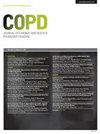载脂蛋白 A1、载脂蛋白 B、载脂蛋白 A1/B 用于急性下呼吸道感染并发慢性阻塞性肺病的致病性预测:一项横断面研究
IF 3.1
3区 医学
Q1 Medicine
International Journal of Chronic Obstructive Pulmonary Disease
Pub Date : 2024-01-26
DOI:10.2147/copd.s441503
引用次数: 0
摘要
目的:探讨载脂蛋白A1(ApoA1)、载脂蛋白B(ApoB)和ApoA1/B比值在急性下呼吸道感染并发慢性阻塞性肺疾病(COPD)病原学诊断中的价值,辅助疾病综合评估:研究共纳入 171 名患有急性下呼吸道感染的慢性阻塞性肺病患者、35 名未患有急性下呼吸道感染的慢性阻塞性肺病患者和 41 名健康对照者。研究采用相关性分析和二元逻辑回归来评估各种因素在慢性阻塞性肺病急性下呼吸道感染中的作用。绘制了接收者操作特征曲线(ROC),并计算了曲线下面积(AUC)值,以评估预测性能:结果:感染是载脂蛋白A1、载脂蛋白B和载脂蛋白A1/B指数发生变化的原因。在急性下呼吸道感染并发慢性阻塞性肺病的病因诊断相关性分析中,年龄、载脂蛋白A1、载脂蛋白A1/B比值、淋巴细胞计数(LYMPH)、中性粒细胞计数(NEUT)、C反应蛋白(CRP)、红细胞沉降率(ESR)和内毒素呈显著相关。在预测急性下呼吸道细菌感染并发慢性阻塞性肺病方面,载脂蛋白 A1 的 ROC 曲线下面积(AUC:0.889)最高,敏感性和特异性分别为 82.9% 和 83.9%。NEUT和载脂蛋白A1的组合提高了预测效果(AUC:0.909;灵敏度/特异性:85.1%/85.7%):结论:载脂蛋白A1、载脂蛋白B和载脂蛋白A1/B比值是预测慢性阻塞性肺病并发急性下呼吸道感染病原体的良好指标,尤其是载脂蛋白A1具有较高的预测价值:载脂蛋白A1、载脂蛋白B、载脂蛋白A1/B、慢性阻塞性肺病、急性下呼吸道感染、病原体本文章由计算机程序翻译,如有差异,请以英文原文为准。
ApoA1, ApoB, ApoA1/B for Pathogenic Prediction of Chronic Obstructive Pulmonary Disease Complicated by Acute Lower Respiratory Tract Infection: A Cross-Sectional Study
Purpose: To investigate the value of apolipoprotein A1 (ApoA1), apolipoprotein B (ApoB), and ApoA1/B ratio in pathogenic diagnosis of chronic obstructive pulmonary disease (COPD) complicated by acute lower respiratory tract infection, assisting comprehensive disease assessment.
Patients and Methods: The study enrolled 171 COPD patients with acute lower respiratory tract infections, 35 COPD patients without acute lower respiratory tract infections, and 41 healthy controls. Correlation analysis and binary logistic regression were used to assess the roles of various factors in COPD with acute lower respiratory tract infections. Receiver operating characteristic (ROC) curves were plotted and area under curves (AUC) values were calculated to evaluate the predictive performance.
Results: Infections were the cause of alterations in ApoA1, ApoB and ApoA1/B index. In correlation analysis for pathogenic diagnosis of COPD complicated by acute lower respiratory infections, age, ApoA1, ApoA1/B ratio, lymphocyte count (LYMPH), neutrophil count (NEUT), C-reactive protein (CRP), erythrocyte sedimentation rate (ESR) and endotoxin were significantly correlated. For predicting COPD complicated by acute lower respiratory tract bacterial infection, ApoA1 had the highest area under the ROC curve (AUC: 0.889), with sensitivity and specificity of 82.9% and 83.9%, respectively. The combination of NEUT and ApoA1 improved the prediction efficacy (AUC: 0.909; sensitivity/specificity: 85.1%/85.7%).
Conclusion: ApoA1, ApoB, and ApoA1/B ratio are good indicators for predicting pathogens in COPD complicated by acute lower respiratory tract infection, especially ApoA1 which has high predictive value.
Keywords: ApoA1, ApoB, ApoA1/B, COPD, Acute lower respiratory tract infection, pathogens
Patients and Methods: The study enrolled 171 COPD patients with acute lower respiratory tract infections, 35 COPD patients without acute lower respiratory tract infections, and 41 healthy controls. Correlation analysis and binary logistic regression were used to assess the roles of various factors in COPD with acute lower respiratory tract infections. Receiver operating characteristic (ROC) curves were plotted and area under curves (AUC) values were calculated to evaluate the predictive performance.
Results: Infections were the cause of alterations in ApoA1, ApoB and ApoA1/B index. In correlation analysis for pathogenic diagnosis of COPD complicated by acute lower respiratory infections, age, ApoA1, ApoA1/B ratio, lymphocyte count (LYMPH), neutrophil count (NEUT), C-reactive protein (CRP), erythrocyte sedimentation rate (ESR) and endotoxin were significantly correlated. For predicting COPD complicated by acute lower respiratory tract bacterial infection, ApoA1 had the highest area under the ROC curve (AUC: 0.889), with sensitivity and specificity of 82.9% and 83.9%, respectively. The combination of NEUT and ApoA1 improved the prediction efficacy (AUC: 0.909; sensitivity/specificity: 85.1%/85.7%).
Conclusion: ApoA1, ApoB, and ApoA1/B ratio are good indicators for predicting pathogens in COPD complicated by acute lower respiratory tract infection, especially ApoA1 which has high predictive value.
Keywords: ApoA1, ApoB, ApoA1/B, COPD, Acute lower respiratory tract infection, pathogens
求助全文
通过发布文献求助,成功后即可免费获取论文全文。
去求助
来源期刊

International Journal of Chronic Obstructive Pulmonary Disease
RESPIRATORY SYSTEM-
CiteScore
5.10
自引率
10.70%
发文量
372
审稿时长
16 weeks
期刊介绍:
An international, peer-reviewed journal of therapeutics and pharmacology focusing on concise rapid reporting of clinical studies and reviews in COPD. Special focus will be given to the pathophysiological processes underlying the disease, intervention programs, patient focused education, and self management protocols. This journal is directed at specialists and healthcare professionals
 求助内容:
求助内容: 应助结果提醒方式:
应助结果提醒方式:


